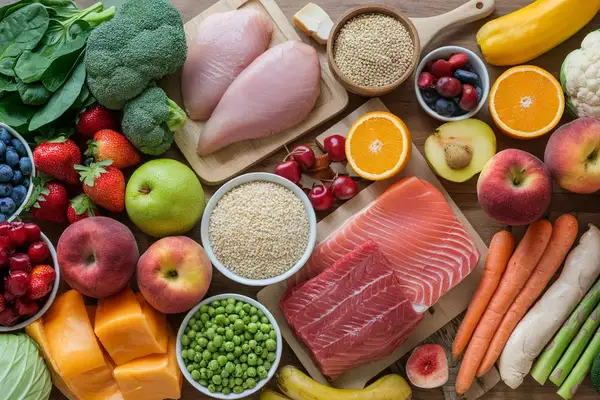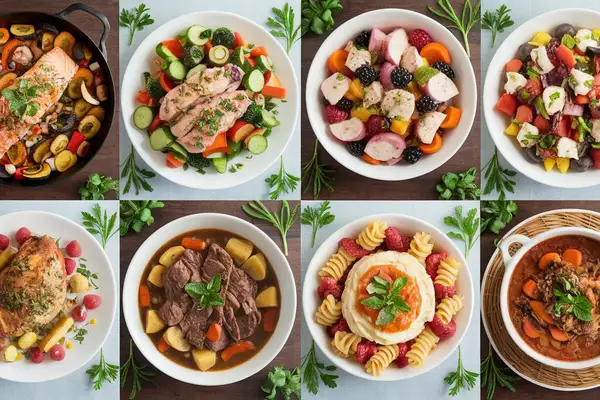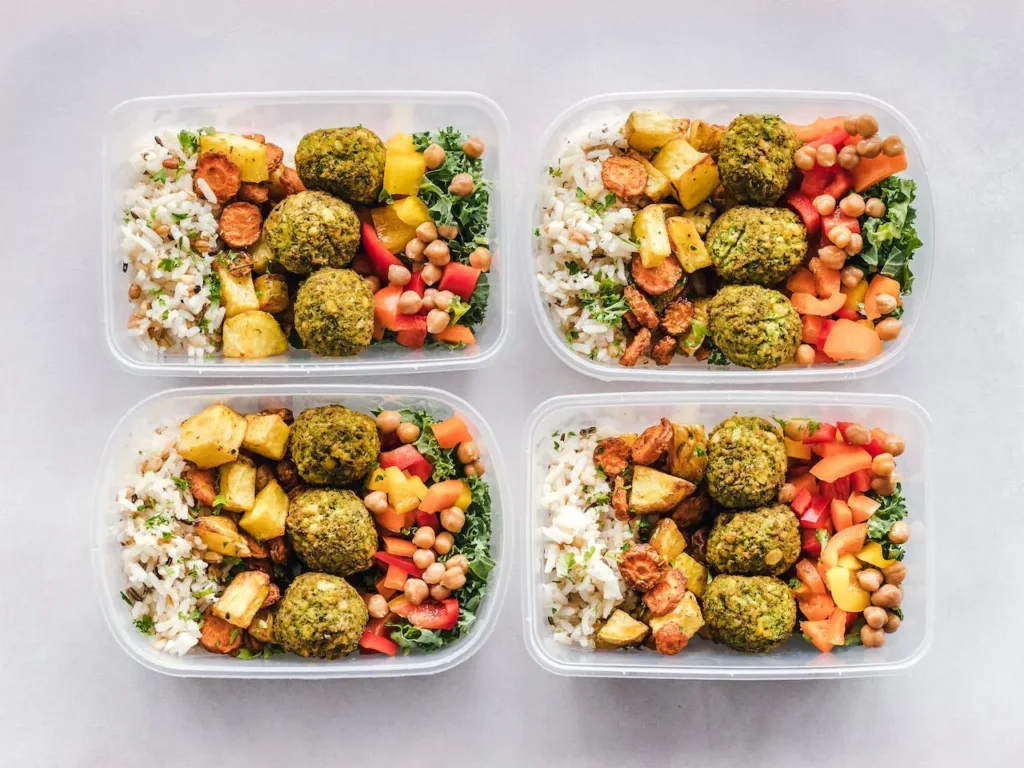7-Day Bone Broth Diet Plan | Discover 12 Health Benefits
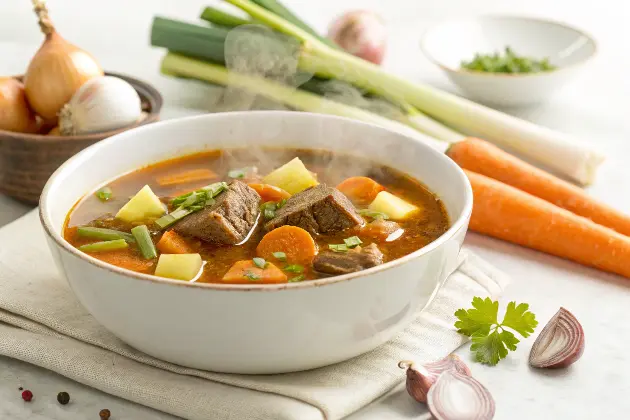
What is Bone Broth?
This post may contain affiliate links, meaning I may earn a commission if you make a purchase, at no extra cost to you. I only recommend products I trust. Thank you for your support.
Bone broth is a rich, savory liquid made by simmering animal bones (often beef, chicken, or fish) and connective tissues in water, sometimes with added vegetables, herbs, and a splash of vinegar for an extended period (anywhere from 8 to 48 hours).
During this slow simmer, collagen and gelatin are released from the bones and cartilage, along with minerals like calcium, magnesium, and phosphorus, and bioactive compounds such as glutamine and glycine.
Because of its nutrient density, bone broth is often sipped on its own or used as the base for soups, stews, sauces, and gravies adding both flavor and a nutritional boost to a wide variety of dishes.
A bone broth diet is a nutritional plan that centers around drinking homemade or high‑quality bone broth regularly, often in place of one or more meals each day.
This 7-day bone broth diet plan features easy high protein bone broth soup recipes that support gut health, reduce inflammation, and promote weight loss.
Key Components of Bone Broth
Bone broth is highly nutritious and provides several key nutrients that are beneficial for your health.
Here are the primary constituents you’ll find in a properly simmered bone broth, along with what each brings to the table:
- Water: The foundational solvent that extracts and carries nutrients, giving bone broth its hydrating base and allowing all other components to disperse evenly.
- Collagen: Bone broth is a fantastic source of collagen, a protein that supports healthy skin, joints, and digestion.
- Gelatin: Gelatin, derived from the collagen in bone broth, aids in gut health and digestion.
- Amino Acids: Glycine and proline play roles in detoxification, sleep regulation, and muscle repair, while glutamine helps maintain the gut barrier and arginine supports circulation and wound healing.
- Glycosaminoglycans (GAGs): Includes glucosamine and chondroitin sulfate for joint cushioning and hyaluronic acid for tissue hydration, collectively enhancing joint mobility and skin elasticity.
- Minerals & Electrolytes: Contains calcium and phosphorus for bone strength, magnesium for over 300 enzyme reactions, and sodium with potassium to regulate fluid balance, nerve conduction, and muscle function.
- Bone Marrow Nutrients: Provides marrow‑derived fats, rich in long‑chain fatty acids for energy and cell‑membrane health and trace amounts of fat‑soluble vitamins (A, D, E, K) plus B‑vitamins, supporting overall nutrient status.
- Trace Elements: Supplies zinc, copper, and manganese in small but vital quantities, acting as cofactors for antioxidant enzymes and connective‑tissue synthesis.
- Flavor & Functional Compounds: Delivers simple peptides and nucleotides (like IMP and GABA) that may support neurotransmitter balance, along with phytonutrients from any added herbs and vegetables.
7-Day Bone Broth Diet Plan (Bone Broth Diet Menu)
This 7-day bone broth diet plan features a variety of nutrient-dense bone broth soups and provides a balanced and satisfying meal plan for each day.
This 7-day bone broth diet plan aligns with the recommendations for consuming bone broth and following a healthy eating regimen for 21 days, including fasting days and eating days.
Here is a detailed breakdown of the daily 7 day bone broth diet plan:
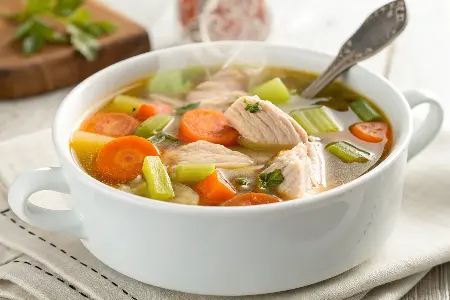
Day 1
Breakfast:
- Bone Broth Smoothie Bowl: Blend 1 cup warm chicken bone broth, ½ banana, ½ cup frozen mixed berries, 1 handful spinach, and 1 scoop collagen powder until smooth.
Lunch:
- Classic Chicken & Vegetable Bone Broth Soup: Simmer 1 cup chicken bone broth with 3 oz shredded chicken, ½ cup diced carrots, ½ cup sliced celery, and ¼ cup frozen peas.
Dinner:
- Beef‑Pho Style Bone Broth Bowl: Bring 1 cup beef bone broth to a simmer with star anise, cinnamon stick, sliced ginger; serve over 2 oz cooked rice noodles with 2 oz thin‑sliced beef, bean sprouts, fresh basil, and lime wedge.
Snacks:
- Bone Broth Poached Egg: Poach 1 egg directly in gently simmering bone broth; season with pepper.
- Bone Broth Gelatin Gummies: Warm 1 cup bone broth, whisk in 1 Tbsp unflavored gelatin, pour into molds, chill until set.

Day 2
Breakfast:
- Savory Bone Broth Oatmeal: Cook ½ cup rolled oats in 1 cup chicken bone broth, finish with chopped scallions and a soft‑boiled egg.
Lunch:
- Miso & Tofu Bone Broth Soup: Dissolve 1 Tbsp white miso into 1 cup warm bone broth, add 2 oz cubed silken tofu, ½ cup wakame seaweed, and sliced scallions.
Dinner:
- Chicken Tortilla Bone Broth Soup: Simmer 1 cup bone broth with 3 oz shredded chicken, ½ cup diced tomatoes, chili powder; garnish with baked tortilla strips, cilantro, and lime.
Snacks:
- Bone Broth “Latte”: Warm 1 cup bone broth with a pinch of cinnamon and nutmeg.
- Marinated Olives in Bone Broth: Toss ½ cup mixed olives with ¼ cup cooled bone broth and herbs; chill.

Day 3
Breakfast:
- Bone Broth Chia Pudding: Stir 3 Tbsp chia seeds into 1 cup bone broth, refrigerate overnight; top with fresh berries.
Lunch:
- Vegetable Ramen in Bone Broth: Simmer 1 cup bone broth with 2 oz ramen noodles, ½ cup sliced mushrooms, baby bok choy, and a soft‑boiled egg.
Dinner:
- Slow‑Cooker Beef & Bone Broth Stew: Combine 3 oz cubed beef, 1 cup beef bone broth, ½ cup diced carrots, ½ cup diced potatoes; cook on low 6 hrs.
Snacks:
- Bone Broth Popsicles: Freeze 1 cup seasoned bone broth into 4 mini popsicle molds.
- Spiced Nuts with Bone Broth Glaze: Toss ¼ cup mixed nuts in 2 Tbsp reduced bone broth and spices; roast until crisp.

Day 4
Breakfast:
- Quinoa Porridge in Bone Broth: Cook ½ cup quinoa in 1 cup bone broth until tender; finish with chopped herbs and a drizzle of olive oil.
Lunch:
- Beef & Barley Bone Broth Stew: Simmer 3 oz diced beef, 1 cup beef bone broth, ¼ cup pearl barley, ½ cup mixed veggies until barley is tender.
Dinner:
- Seafood Chowder with Fish Bone Broth: Warm 1 cup fish‑based bone broth with 2 oz mixed seafood, ¼ cup corn kernels, ¼ cup diced potatoes, and a splash of milk.
Snacks:
- Bone Broth Deviled Eggs: Mix 2 egg yolks with 1 Tbsp bone broth and mustard, refill whites.
- Bone Broth‑Marinated Cherry Tomatoes: Marinate ½ cup cherry tomatoes in bone broth and herbs for 1 hr.
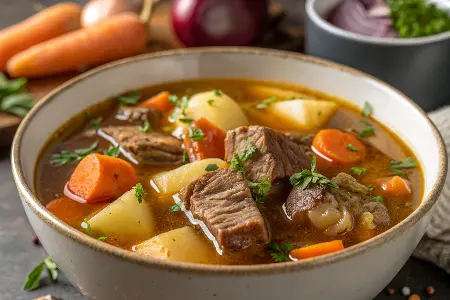
Day 5
Breakfast:
- Scrambled Eggs in Bone Broth: Whisk 2 eggs with ¼ cup bone broth; scramble in a nonstick pan with baby spinach.
Lunch:
- Turkey, Kale & Bone Broth Soup: Simmer 3 oz diced turkey breast, 1 cup bone broth, ½ cup chopped kale, and diced carrots until kale wilts.
Dinner:
- Lamb & Root Vegetable Bone Broth Stew: Cook 3 oz lamb cubes in 1 cup bone broth with ½ cup diced carrots and parsnips until tender.
Snacks:
- Chilled Bone Broth Shot: Serve 1 oz bone broth cold in a shot glass with a squeeze of lemon.
- Bone Broth‑Infused Hummus: Blend ½ cup chickpeas with ¼ cup bone broth, garlic, and tahini.
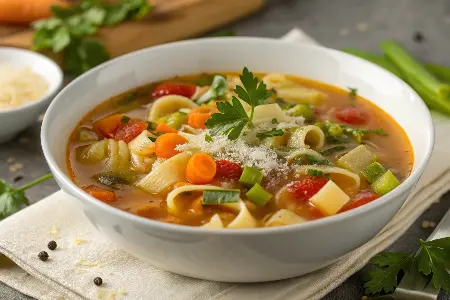
Day 6
Breakfast:
- Bone Broth Sweet Potato Hash: Sauté ½ cup diced sweet potato in 2 Tbsp bone broth until tender; top with a fried egg.
Lunch:
- Minestrone‑Style Bone Broth Soup: Combine 1 cup bone broth, ½ cup mixed beans, ½ cup zucchini, ½ cup diced tomatoes, and Italian herbs.
Dinner:
- Pork, Apple & Bone Broth Soup: Simmer 3 oz lean pork loin, 1 cup bone broth, ½ cup diced apple, and onion until pork is cooked through.
Snacks:
- Bone Broth‑Poached Shrimp: Poach 2 oz shrimp in simmering bone broth; serve with cocktail sauce.
- Avocado‑Bone Broth Dip: Mash ½ avocado with 1 Tbsp bone broth, lime juice, and cilantro.
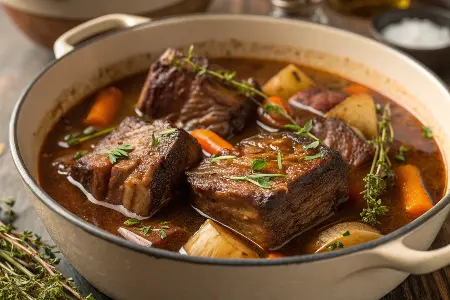
Day 7
Breakfast:
- Buckwheat Pancakes with Bone Broth: Whisk ½ cup buckwheat flour, ½ cup bone broth, and 1 egg into batter; cook 3 small pancakes.
Lunch:
- Cheese Tortellini in Chicken Bone Broth: Heat 3 oz cheese tortellini in 1 cup bone broth with 1 handful spinach and grated Parmesan.
Dinner:
- Braised Short Ribs in Bone Broth: Braise 3 oz beef short ribs in 1 cup beef bone broth with garlic and rosemary until fall‑off‑the‑bone.
Snacks:
- Ginger Bone Broth Tea: Simmer 1 cup bone broth with 3 slices fresh ginger; strain and serve.
- Turkey Meatballs in Bone Broth: Gently heat 2 small turkey meatballs in 1 cup warm bone broth.
Health Benefits of Bone Broth
The bone broth diet is designed to promote weight loss, improve gut health, and provide a range of essential nutrients to the body.
Here are 12 benefits of bone broth:
- Promotes Gut Health: The gelatin in bone broth can help restore the gut lining, improving digestive health and potentially alleviating symptoms of leaky gut syndrome.
- Rich in Nutrients: Bone broth is packed with vitamins and minerals like calcium, magnesium, phosphorus, and potassium, which support overall health.
- Helps with Weight Loss: Bone broth is low in calories but high in protein, making it a filling, nutrient-dense food that can help with weight loss by reducing hunger.
- Supports Joint Health: Bone broth contains glucosamine, chondroitin, and gelatin, which are known to improve joint function and reduce symptoms of osteoarthritis.
- Strengthens Bones: Bone broth contains a variety of minerals, such as calcium and magnesium, that help maintain bone density and strength.
- Improves Skin Health: The collagen content in bone broth is believed to promote skin health and elasticity, potentially benefiting individuals seeking to improve skin appearance and health.
- Supports Detoxification: The amino acids in bone broth, such as glycine, assist the liver in detoxifying the body by improving its ability to remove toxins.
- Boosts Immune System: The amino acids in bone broth, such as glutamine, may support immune function helping you fight off infections and illnesses and overall immune health.
- Promotes Healthy Hair and Nails: The collagen and gelatin in bone broth can strengthen hair and nails, promoting growth and preventing breakage.
- Improves Sleep Quality: Glycine in bone broth has been shown to promote better sleep by calming the nervous system and enhancing sleep quality.
- Reduces Inflammation: Some components in bone broth, such as chondroitin sulfate and glucosamine have anti inflammatory properties that may help reduce chronic inflammation in the body.
- Boosts Hydration: Bone broth is a good source of electrolytes, which help to maintain proper hydration levels, especially after exercise or illness.
- Supports Muscle Repair: Bone broth is rich in protein and amino acids, such as glutamine, which are essential for repairing muscles and tissue, making it beneficial for athletes or those recovering from injury.
Bone Broth Side Effects
Bone broth, while generally considered safe to consume, may have some potential risks to be aware of, including:
- Lead Contamination: Studies show elevated levels of lead in bone broths, which can be harmful to health if consumed in large amounts.
- Bacterial Contamination: Improper preparation and storage of bone broth can lead to bacterial growth, increasing the risk of foodborne illness.
- Allergic Reactions: Bone broth may contain allergens such as dairy or shellfish, so it is important to check the ingredients before consuming.
- Interaction with Medications: Bone broth contains amino acids and minerals that can interact with certain medications, such as blood thinners.
- Gas and Bloating: Some individuals may experience gas and bloating due to the high gelatin content in bone broth. Gelatin is beneficial for gut health, but it can cause digestive discomfort in some people.
- Histamine Intolerance: Bone broth can be high in histamines, especially if it has been simmered for a long time and individuals may experience symptoms such as headaches, nausea, fatigue, and skin reactions.
- High Sodium Content: Commercially prepared bone broth can be high in sodium, which may be problematic for individuals with hypertension or those on a low-sodium diet.
How to Prepare Bone Broth
Preparing bone broth is a straightforward process that involves simmering bones, vegetables, herbs, and spices to extract their nutrients and flavors.
Here’s a general guide to preparing bone broth:
Ingredients
- Bones: Chicken, beef, or fish bones are commonly used.
- Water: Sufficient water to cover the bones and ingredients in the pot.
- Vegetables: Onions, carrots, celery, and other aromatic vegetables for flavor.
- Herbs and Spices: Bay leaves, peppercorns, and any preferred herbs and spices.
Step-by-Step Preparation
1. Select Bones
- Use high-quality bones, preferably from organic and grass-fed animals, to maximize the nutritional content of the broth.
- You can use raw or cooked bones, and including some connective tissue (such as chicken feet or beef knuckles) can enhance the gelatin content of the broth.
2. Roast the Bones (Optional)
- For added flavor, you can roast the bones in the oven at 400°F (200°C) for 30-45 minutes before simmering them. This can enhance the depth of flavor in the broth.
3. Prepare the Vegetables
- Roughly chop onions, carrots, and celery, and any other desired vegetables. These will add flavor and nutrients to the broth.
4. Simmering
- Place the bones and vegetables in a large stockpot or slow cooker and cover them with water.
- Add herbs, spices, and a small amount of vinegar (such as apple cider vinegar) to help extract minerals from the bones.
5. Simmer Time
- Bring the pot to a boil, then reduce the heat to a low simmer.
- Cover the pot and let the broth simmer for at least 12-24 hours.
- The longer simmering time allows for more nutrients to be extracted from the bones and connective tissues.
6. Skimming
- Occasionally skim off any foam or impurities that rise to the surface of the broth during the simmering process.
7. Strain and Cool
- Once the broth has simmered to your satisfaction, remove the bones and vegetables, and strain the liquid through a fine mesh strainer.
- Allow the broth to cool, then refrigerate it. As the broth cools, a layer of fat may form on the surface, which can be removed if desired.
8. Storage
- Store the cooled bone broth in airtight containers in the refrigerator for up to 5 days, or freeze it for longer-term storage.
Tips
- Use a ratio of about 2 pounds of bones per gallon of water for a concentrated broth.
- Experiment with different herbs and spices to customize the flavor of the broth.
- Consider using a slow cooker for convenience and ease of long, slow simmering.
Bone Broth Recipes
To help you get started with the bone broth diet plan, here are a few bone broth recipes that you can incorporate in the 7-day bone broth diet plan:
1. Bone Broth Vegetable Soup
Ingredients
- 4 cups bone broth
- 1 cup mixed vegetables (carrots, celery, onions)
- 1 garlic clove
- 1 teaspoon dried herbs, salt and pepper to taste
Instructions
- In a pot, sauté the vegetables and garlic until tender
- Add the bone broth, dried herbs, salt, and pepper
- Simmer for 20 minutes
- Serve hot
2. Bone Broth Chicken Curry
Ingredients
- 2 cups bone broth
- 1 cup cooked chicken
- 1 onion
- 2 cloves garlic
- 1 teaspoon curry powder
- 1 teaspoon turmeric, salt and pepper to taste
Instructions
- In a pan, sauté the onion and garlic until golden
- Add the cooked chicken, curry powder, turmeric, salt, and pepper
- Stir in the bone broth and simmer for 15 minutes
- Serve with steamed rice
3. Bone Broth Berry Smoothie
Ingredients
- 1 cup bone broth
- 1 cup mixed berries
- 1 banana
- 1 tablespoon almond butter
- 1 tablespoon honey
Instructions
- In a blender, combine all the ingredients and blend until smooth
- Pour into a glass and enjoy as a refreshing snack or breakfast
Conclusion
The 7-day bone broth diet plan is a powerful tool for boosting your health and shedding those extra pounds.
With its rich nutritional value and numerous benefits, it’s no wonder that this diet plan has gained so much popularity.
By following the meal breakdown and incorporating the sample recipes provided, you can embark on a journey of improved well-being and weight loss.
Remember to consult with a healthcare professional before starting any new diet plan, and stay consistent to achieve the best results.
So, are you ready to try the ultimate 7-day bone broth diet plan and transform your health?
- 7-day diet plan for high blood pressure
- 2-week no sugar meal plan
- Get rid of PCOS belly fat with these 9 proven strategies
- 7-day PCOS diet meal plan
- The menopause diet: 5 day meal plan
- Is olive oil good for dogs?
- 7-day 1600 calorie meal plan high protein
- 7-day 1400 calorie meal plan high protein
- Caretaker vs caregiver
- Mediterranean diet breakfast ideas
- 7-day carb cycling meal plan
- Intermittent fasting meal plan for beginners
- 7-day meal plan for prediabetes
- 7-day meal plan for gestational diabetes
- 7-day meal plan for ulcerative colitis
- 7-day meal plan for kidney disease
Frequently Asked Questions (FAQs)
How to make my own bone broth?
Simply simmer bones, vegetables, and seasonings in water for an extended period of time to extract the nutrients and flavors.
Can I continue the bone broth diet plan beyond the 7 days?
The 7-day bone broth diet plan is a short-term plan designed to kickstart weight loss and improve health. It’s recommended to transition to a balanced and sustainable eating plan after completing the 7 days to maintain long-term results.
Is the bone broth diet plan suitable for vegetarians or vegans?
The bone broth diet plan is primarily based on animal bones and connective tissues, making it unsuitable for vegetarians and vegans.
However, there are alternative options available, such as vegetable broth or mushroom broth, that can be used as a substitute.
Are there any side effects of the bone broth diet plan?
While the bone broth diet plan is generally safe for most individuals, some people may experience digestive discomfort, such as bloating or diarrhea, due to the high collagen content.
Can I drink bone broth on its own without incorporating it into meals?
Yes, you can drink bone broth on its own as a standalone beverage. However, for the bone broth diet plan, it is recommended to incorporate it into meals to ensure a balanced and nutrient-rich diet.
What is bone broth?
Bone broth is a nutrient-rich liquid made by simmering bones (often from chicken, beef, or fish) along with vegetables, herbs, and spices.
